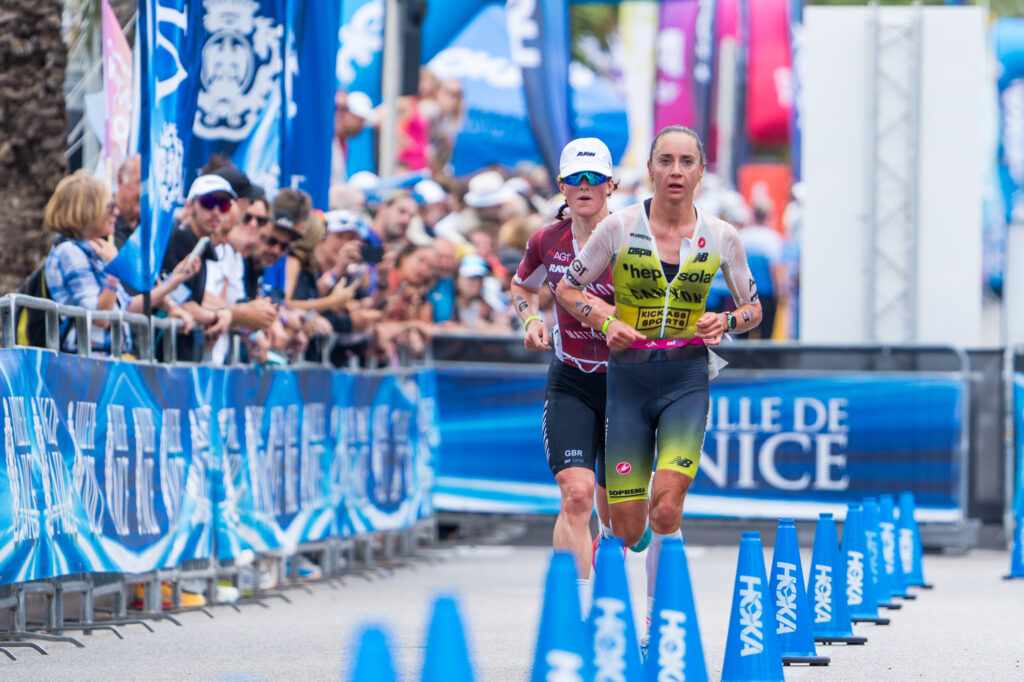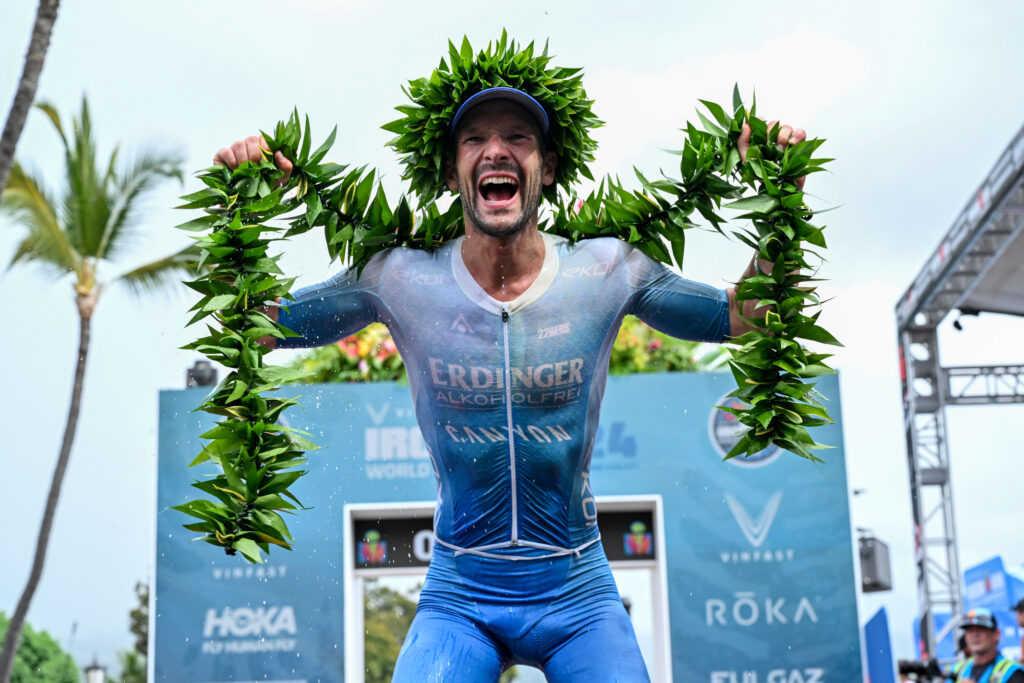A Love Letter to the Full Distance Triathlon

Laura Philipp and Kat Matthews at the IRONMAN World Championship Nice, 2024. Photo: Kevin Mackinnon.
We have had an embarrassment of riches when it comes to professional triathlon racing in 2025. Records have fallen. New faces have emerged to take wins, while some written off as perhaps past their prime have also risen to claim victories. Between World Triathlon, T100, and IRONMAN (and with the always excellent Challenge Roth right around the corner), there’s simply a lot going on, all the time.
I suppose it’s in the context of that saturated landscape in which we sit today that I’ve come to realize that it makes the value of full-distance racing more critical than ever. And that there is perhaps nothing else quite like it in sport — and maybe, just maybe, where we collectively as an industry need to do a better job telling that story.
Let me get the obvious statement out of the way: it is a much tougher ask of your audience to watch a nine-ish hour long live broadcast. Literally any other format of triathlon might be easier to digest. And the racing across every distance from super sprint to 70.3 is explosive and compelling. The broadcast product itself is easier, with smaller courses, tighter racing and less demand on your announcers to be entertaining. It’s one of the reasons why T100 and Supertri have, by most measures, the most complete broadcast product for triathlon.
And yet…it’s always the full distance races I find myself circling on the calendar.
I think there’s a couple of reasons that tends to be the case. The first is simple: if you are a triathlete of a certain age (read: elder millennial on up), it is most likely that your first connection to the sport came through the full distance. Not to beat a long dead horse, but there’s a reason why commentators continue to reference Julie Moss and her crawl to the finish, or the Iron War — it’s because those reference points are moments in time that are likely your first touch point to triathlon, period.
The second is that the struggle that professionals face at the full distance are more relatable than they are at shorter distances. Although we continue to see records fall across distances, the speed at which athletes complete full-distance racing is at least somehow fathomable, or relatable, to a broader audience. So, too, is the type of catastrophic blow-up that we see out of athletes gunning for a win. How many of us have been reduced to tears, as Matthew Marquardt has been, with quad cramping? It’s those moments that bring us closer to the shared athlete experience that is critical to our sport.

Patrick Lange wins the IRONMAN World Championship Kona, 2024. Photo: Donald Miralle for IRONMAN
But most importantly, I would argue, the race product lends itself to having the most dramatic of endings. Quite simply, racing shorter than 140.6-miles is too short to have someone come back from some type of mistake, whether it be self inflicted (for instance, a penalty), or course inflicted (flat tire / mechanical issue). There’s a reason why people pull the ripcord at shorter races when they lose the front of the field; it’s simple math that your best chance at a paycheck is to cut your losses and take a start elsewhere.
Full-distance racing, on the other hand, is such a long day that you have enough time to glue the wheels back on. Take Marquardt’s rise from the dead from cramping out of the water to winning at Cairns, or Mirinda Carfrae’s charge to the 2014 IRONMAN World Championship (infamously, written off by the commentary team at the start of the marathon). Combine it with the razor’s edge margin that athletes are frequently running at towards the end of an event, and you can have plenty of final-mile dramas.
It’s not perfect, of course. We need more cameras on athletes, and we need them in scenarios that are safer for athletes (e.g., drones, where permitted, instead of motorcycles on bike courses). Perhaps we could see the proliferation of this type of camera, developed for the new Formula 1 film, to get racer-eye views while cycling for a change of pace. And we still need the best athletes showing up at a few select races on the calendar, instead of being scattered about, to produce the best product.
But it’s still the full for me. I may not be able to race it well, but it’s my preferred event for professionals. And we’ve got some good ones on the horizon, with IRONMAN Frankfurt, Challenge Roth, and IRONMAN Lake Placid all in the next four weeks.




Don’t you (or do you) think the set of IM Pro Series full distance races meets your ‘need’.
No sensible athlete races more than two ‘regular season’ full distances before the IMWC so you cannot practically get ‘all’ the best athletes racing twice against each other. But Frankfurt is pretty stacked for the men - who, top pile, is distracted by Roth? (and wtf is Laidlow racing there as opposed to validating for Nice??) The only MPro I see in the top 8 in Nice ON FORM who is not racing in Frankfurt is MvR, and maybe Lopez and Marquardt. Sanders, Long, Riddle, Foley? On form . . . nope.
id say the reason they have this is because they have commentators who actually prepare for the race, rather than most ironman commentators being clueless about half the field.
if the ironman commentators would actually really follow the sport outside the usa they would be a lot better.
its kind of crazy for a couple of thousand bugs ironman manages to ruin its show
as one would have to assume iroman does not pay for the prep because otherwise they would look for prepared commentators.
There should really be 5 top tier full distance races a year, with obviously IMWC the crown of them; Roth should be the summer big one, and then we can argue about the other 3 and what they should be.
Dump 90% of the KQ slots there (and yes, IM, you could do this with Challenge if you really wanted to), and let’s get some fun going.
Call it the IM World Champ Series. Then the “Pro Series” is the mid tier, lower prize money, need to qualify into the World Champ series, and away we go.
But…that’s if I ruled the world. (Also hat tip to Ben Hobbs and Dark Mark for having that idea 10+ years ago).
What I appreciate the most about IM event distances and a broadcast. For the most part, you can come and go and not really “miss much”. Once you know the splits at T1, you pretty much know what the rest of the bike is going to look like, so then it’s just a matter of sorta checking in and confirming, and then checking back in 1 hour later, and seeing how the tactics have played out. So in a way it almost makes it ok to only watch not even half the telecast. Now obviously in other sports that would be sorta a nuts way of doing it ,but for the most part because of it’s endurance nature, your not really missing all that much if you step away for an hour + and then come back.
It’s not too dissimilar from most stage cycling events – you can typically check out for a while before knowing where on the course things should be happening.
But yes, have the live broadcast, then put together a 30-35 min YouTube highlights video, which then in theory should monetize with ads beyond the standard sponsorship packages…
I think this would be a great model, similar to World Tour/Pro Tour cycling, PGA Tour/Korn Ferry Tour (with some elevated purse events on the PGA tour), MLB / MiLB, NBA / G League.
This would also help alleviate some of the issues that people have raised with having pros of varying ability on the course on the same time. See the discussion around LCB and the pro male on the run at Eagleman.
They kinda do this already, but its infrequent, late, or part of some other package.
E.g. Here’s a 45 min cut of IMSA. Why only South Africa and not their other races? I dunno, but they should do it for the others. (They also did Geelong, and then that’s it)
Similarly, here’s a highly polished view of 2024 IMLP - a whole 11 months after the race. I get that what they’re to do is hype up the next IMLP, but these things really need to be published a day or two after the actual race. If they’re focusing on the pros, then move the inspirational stories to some other video and just show the pros. Watching it, it felt weird trying to follow last year’s pro series standings, and having Sanders extoll the virtues of last year’s training philosophy. We really don’t need the long form interview with each pro in contention - just give us a synopsis of each athlete.